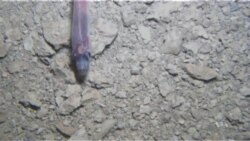There is life, hundred of meters under Antarctica's Ross Ice Shelf.
Northern Illinois University geology professor Reed Scherer saw the thriving marine community on video monitors connected to a Remotely Operated Vehicle (ROV) sent down a borehole in the ice. The ROV, known as Deep SCINI - for Submersible Capable of under Ice Navigation and Imaging - explored a 400-square meter cavity 740 meters below the ice.
“It is a very mobile environment,” Scherer marvelled. “The bottom is changing constantly. We saw things that swim and things that crawl. Obviously they are getting enough nutrition that they can thrive. Some of the little crustacean-like creatures swam quickly and were quite active.”
The location is the farthest south that fish have ever been seen.
Fish community discovered
Scherer was on a 40-person team that has just wrapped up a National Science Foundation-funded expedition to the Ross Ice Shelf, the world’s largest floating ice sheet, about the size of Spain. He admits he was surprised to find fish. “The central focus of the research was to try to get some actual physical constraints on what the ice sheet looks like over time and what it is doing right now.”
His colleague Ross Powell led the expedition, which put tractors on the ice to pull electric generators, tents, science labs, heavy equipment and other supplies1,000 kilometers from the McMurdo Station to their research site. It was downstream from the subglacial lake where the two geologists worked in 2012-13. That project discovered abundant microbial life. DNA analysis of the lake water and sediment found some 4,000 viable species in the lake water and about 2,500 in lake sediment.
“We tried to understand the environment there, both ecologically and in terms of the ice dynamics about how the lake operates, how the sediment underneath the ice sheet operates as well.” Powell says. “It is the water and the sediment underneath the ice that controls how fast the ice is flowing into the ocean.”
Geologic past and future
During this expedition, the researchers targeted an area called the grounding zone, where Antarctic ice, land and sea converge. Powell says the site may provide new evidence that can help predict the effect of climate change on rising sea levels.
“We have found these are very sensitive areas to the stability of how dynamic the ice is and how fast the ice may react to increases of melting both from the ocean and the atmosphere.”
Using a new hot water drill developed and built by the University of Nebraska-Lincoln, researchers cleanly bore down 740 meters. For the first time, they collected water and sediment samples from the grounding zone and by chance, discovered the fish, “some of which,” Powell says, may be new to science.
Analysis offers clues
Ice and sediment cores were also extracted for future analysis. They may offer clues about how the creatures got here, what they feed on and the impact the retreating ice might have on them.
“We know that the ice is melting there at the moment and so by opening up the cores once they get back, we hope to be able to understand what the ice was doing in the past, relative to what it is doing now," Powell explained.
He says the work raises more questions than it answers. Together with other researchers, he is planning to apply for another grant to return to the frozen continent.






